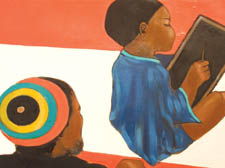|
|
 |
| |
A Caribbean hothouse for the arts in a cold climate
Angela Cobbinah sees an exhibition that celebrates how West Indian migrants gained a foothold on London’s arts
scene in the 1960s
FORTY-one years ago a group of intellectuals from the Caribbean would regularly gather in a tiny flat in Mecklenburgh Square, Bloomsbury, passionately thrashing out ideas into the small hours.
Their host was the Barbadian playwright and poet Edward Kamau Brathwaite and among the guests were writer and political activist John La Rose, who had arrived from Trinidad in 1961.
In that same year, 1966, the two would help found the Caribbean Artists Movement (CAM) to widen the debate about art, politics and identity.
With a membership ranging from established figures such as the academic CLR James, to youngsters like the performance poet Linton Kwesi Johnson, the movement had an enormous impact on Caribbean arts in Britain.
In its intense five-year existence it set the dominant artistic trends, at the same time forging a bridge between West Indian migrants and those who came to be known as black Britons.
That immense legacy is examined in Visions of Consciousness, an exhibition at gallery:space, a new gallery set in the heart of Finsbury Park.
On display is the work of visual artists of the day, photographic records, film, as well as original books to reveal what co-curator Shiri Shalmy describes as CAM’s “secret history”.
Sarah White attended those early gatherings at Brathwaite’s digs in William Goodenough House with her partner, La Rose.
“There would be seven or eight people who would talk passionately right through the night,” she recalls fondly.
“The discussions were always open-ended and that is why we valued them so much.”
Caribbean art and the social role of its proponents would go on to be explored through CAM seminars, workshops, readings, exhibitions and its newsletter. Among the popular venues was the Keskidee Centre, off the Caledonian Road, in Islington.
Brathwaite’s momentous reading of his epic poem Rights of Passage at the Jeannetta Cochrane Theatre in Holborn, articulating the experiences of West Indian migrants in Britain using the rhythms of everyday speech, set the tone of what was to come.
“It was a tremendously exciting reading,” recalls White. “People had never heard of anybody like Eddie as British poets didn’t have that performance tradition in those days.”
At the same time, La Rose and White founded a publishing company, New Beacon Books, whose output reflected the preoccupations of the movement. The two of them would go round to meetings with bags of books to sell.
Apart from published writers such as Brathwaite and CAM co-founder Andrew Salkey, who were products of the cultural and political ferment taking place in the Caribbean at the time, the movement also drew in other kinds of artists.
They included the now internationally acclaimed textile artist Althea McNish, whose colourful drapes would adorn CAM meetings.
“I was born with a paintbrush in my mouth,” declares McNish with a smile as expansive as her designs.
After arriving in “bloody cold” Britain from Trinidad at the age of 18 to eventually study at the Royal College of Art, her talent was quickly spotted by upmarket West End store Liberty’s, which began commissioning her work for fashion and furnishing fabrics.
They included the famous Golden Harvest print inspired by the wheat fields of England, says McNish with a dreamy look in her eye.
A newcomer to the movement, Errol Lloyd, came to Britain from Jamaica to study law. But with the protests of the US civil rights movement ringing in his ears, he found himself compelled to paint and sculpt instead. Astonishingly, Lloyd never attended art school, but soon came to win important commissions.
“I was self-taught and worked in isolation until I was introduced to Caribbean Artists Movement,” he says. “I met older artists like the sculptor Ron Moody and they acted like role models for me. From there my work developed.”
Lloyd went on to illustrate children’s books and is now an established children’s author and illustrator.
In 1972 CAM ceased as a formal organisation as some of its leading lights left Britain for good. The 1971 Immigration Act also put a stop to the wave of Caribbean migrants and signalled the arrival in public consciousness of the “born here, here to stay” generation of black Britons.
“The idea had been to establish a Caribbean aesthetic and by the ’70s they had managed to do that,” states White.
It was left to individuals like La Rose, who died last year, to maintain the movement’s legacy, in particular via New Beacon Books, which acquired a shopfront in Stroud Green Road, Finsbury Park, in 1973.
Aside from his involvement in a range of political campaigns, including the Black Parents Movement, he helped establish the grandly named International Book Fair of Radical Black and Third World Books, which was held at the Camden Centre in King’s Cross, Islington Town Hall and other venues between 1982 and 1995.
“The Caribbean Artists Movement pushed the boundaries of what was considered to be art,” Shalmy explains against the backdrop of Franco Rosso’s 1979 film of Linton Kwesi Johnson in Dread Beat and Blood, part of the retrospective.
“Above all, it established what Caribbean art was.”
The painting on the cover of Review, from the exhibition, is Errol Lloyd’s The Lesson (1972)
Accompanying events:
 |

|
 |
|
 |
|


